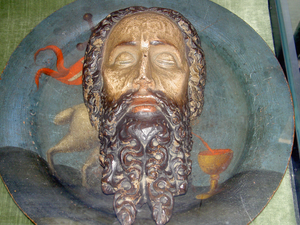
Yet another example of religiously (and probably nationalistically) motivated pseudoarchaeology has emerged in the news. A Bulgarian archaeologist and at least one overly nationalistic politician with a bad mouth claim to have discovered the remains of Saint John the Baptist in a small reliquary made of alabaster found under the basilica of an ancient monastery.
The remains include a few small cranial, dental, and other bone portions identified as from a hand. On the reliquary, a specially designed container for “holy” relics, is an inscription that includes, “Sveti Ivan,” which means “Saint John,” along with the date June 24, a day traditionally considered as St. John’s birthday.
Thats it. That’s all the evidence apparently necessary for archaeologist Kazimir Popkonstantinov and Minister Bozhidar Dimitrov to safely conclude that they have, indeed, found the mortal remains of Saint John the Baptist.
Never mind that relic fraud was a common practice in antiquity. Never mind the stories of Saint John’s death and distribution of his remains are inconsistent with what is claimed to be found. Never mind that it appears to be in the best interests of a certain nationalist politician to have a sensational find.
Perhaps this is the remains of John the Baptist. My natural skepticism of religious claims on reality isn’t the reason I make the accusation of pseudoscience. Its the rush to conclusion and the sensationalist propaganda that gives the unwary public of Bulgaria (and the world) the impression that archaeology is being done–proper, scientific archaeology.
In fact, quite the opposite is happening. We already know that early churches (as well as modern ones!) are willing to claim possession of of relics that belong to demigods and sub-deities they refer to as “saints” in order to motivate and inspire their tithing memberships. We already have examples of medieval frauds used in this way (the shroud of Turin, for example).
What we don’t have are strontium analyses of these bones, which might reveal whether or not the individual traveled the Near East in the same places as John were alleged to. Or comparisons of the bones to determine if they are even of the same individual. Or of the same sex as John! There aren’t even any radiocarbon dates of the remains that I’ve been able to locate.
But even a simple literary review would reveal some problems with either the remains or what is believed known of John. The cranial remains and post-cranial remains, by legend, are to have been separated. Yet the reliquary has remains that are both cranial and post-cranial. If any of the remains belong to John, then either some do not or what is believed “known” about the man is wrong.
Leave a Reply
You must be logged in to post a comment.